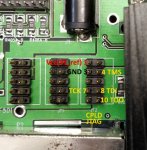Nope. I came unstuck when I couldn't find any of my Xilinx programmers, or a laptop with a real parallel port, so easiest route was asking if anyone had a scrap board, with in all likelihood the IC being protected anyway.
I'd traced back the programming header (pic attached). Given that availability of surplus boards looks to have dried up, I suppose I might as well try reading. I need to get a new programmer anyway, to persuade the others to come out of hiding since my last house move.
Irritatingly you only need a few resistors if you have a PC with a parallel port. I designed in an XC9536 programmer to a lasershow DAC I did a decade or so ago.
http://www.die4laser.com/die4dac/index.htm






